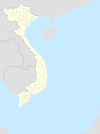
Tết, short for Tết Nguyên Đán (Spring Festival,Lunar New Year, orVietnamese Lunar New Year is the most important celebration in Vietnamese culture. The colloquial term "Tết" is a shortened form of Tết Nguyên Đán, with Sino-Vietnamese origins meaning "Festival of the First Morning of the First Day". Tết celebrates the arrival of spring based on the Vietnamese calendar, which usually has the date falling in January or February in the Gregorian calendar.

Traditional Vietnamese music encompasses a large umbrella of Vietnamese music from antiquity to present times, and can also encompass multiple groups, such as those from Vietnam's ethnic minority tribes. Throughout its history, Vietnam has been most heavily influenced by traditional Chinese music, along with Korea, Mongolia and Japan.

The culture of Vietnam is one of the oldest in Southeast Asia, with the Bronze Age Đông Sơn culture considered to be one of its most important progenitors for its Ancient history. Vietnamese culture was heavily influenced by Chinese culture due to the 1000 years of Northern rule. In this period of time Vietnamese was written with Chinese characters. This large impact on Vietnamese culture meant that Vietnam is often considered to be part of the East Asian cultural sphere.
Australia is home to several large immigrant communities from every continent in the world.
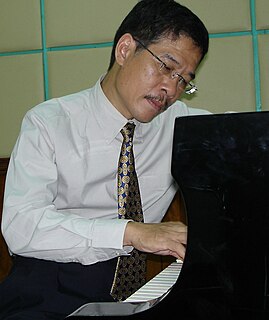
Đặng Hữu Phúc is a Vietnamese pianist and composer best known for his film scores. A graduate of the Hanoi Conservatory, he has penned over 60 works, primarily for film and theatre.

Dương Triệu Vũpronunciation (help·info)(born January 1, 1984 in Cam Ranh, Vietnam) is the stage name of Tuấn Linh, a singer on the popular Vietnamese diaspora music show Paris By Night.

Paris By Night 83: Những Khúc Hát Ân Tình is a Paris By Night program that was filmed at the Charles M. Schulz Theatre at Knott's Berry Farm in Buena Park, California on Saturday, May 27, 2006. It is the first program to be released to a 3-disc DVD format on Thursday, September 21, 2006. The first two discs are Part I and Part II of the music program. And the third disc is special features, mainly documentaries about the composers featured in this program. The third disc also includes two bonus MTV music videos.
Nhã nhạc is a traditional music of Vietnam. Vietnamese court music is very diverse, but the term nhã nhạc refers specifically to the Vietnamese court music performed from the Trần dynasty of the 13th century to the Nguyễn dynasty at the end of the 20th century.

Theatre of Vietnam comprises many traditional forms of drama which survive and retain their popularity to varying degrees. It formed during the Đinh Dynasty, when the Đại Cồ Việt state was born. Water puppetry is a distinctively Vietnamese art form which arose in the 12th century in which a split-bamboo screen obscures puppeteers, who stand in water manipulating the puppets in front of the screen using long poles. Water puppetry is currently popular with tourists to Vietnam. With the success of the August Revolution in 1945, theatrical art entered a new creative period including a new type of theater based on the music of local folk tunes.

Vietnamese art is visual art that, whether ancient or modern, originated in or is practiced in Vietnam or by Vietnamese artists.
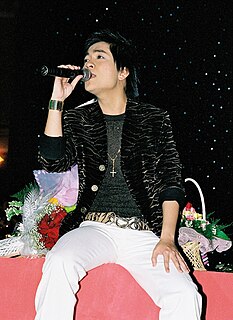
Nhật Sơn, real name Vũ Minh Sơn, Ho Chi Minh City Vietnam, August 29, 1981 - Ho Chi Minh City Vietnam, September 14, 2013. He was the son of Nghệ sĩ Minh Cảnh and Nghệ sĩ Kiều My.
By age six, he started performing, singing traditional Vietnamese Cải lương music and Vietnamese pop songs as well under the stage name Cảnh Sơn. He travelled throughout the country with a group of famous singers and comedians like Siu Black, Thanh Lam, Quang Linh, Minh Thuận, Duy Ngọc, Duy Phương, Hương Loan, Ngọc Thành and his sister Kiều Nhi, and became well-known with the songs ‘Lòng mẹ’ (Ngọc Sơn) and ‘Còn thương rau đắng mọc sau hè’ (Bắc Sơn).

Emperor Quang Trung or Nguyễn Huệ, also known as Nguyễn Quang Bình, was the second emperor of the Tây Sơn dynasty, reigning from 1788 until 1792. He was also one of the most successful military commanders in Vietnam's history. Nguyễn Huệ and his brothers, Nguyễn Nhạc and Nguyễn Lữ, together known as the Tây Sơn brothers, were the leaders of the Tây Sơn rebellion. As rebels, they conquered Vietnam, overthrowing the imperial Later Lê dynasty and the two rival feudal houses of the Nguyễn in the south and the Trịnh in the north.

Paris By Night 91: Huế, Sài Gòn, Hà Nội is a Paris By Night program produced by Thúy Nga that was filmed at the Terrace Theater at the Long Beach Convention and Entertainment Center on January 12, 2008 and January 13, 2008.
Trần Thu Hà, also known as Hà Trần is a Vietnamese singer and producer. She is considered by the public and critics as one of the four divas in Vietnam, alongside Thanh Lam, Hồng Nhung, and Mỹ Linh.
Quang Lê is one of the top selling Vietnamese-American recording artists, renowned for his unique covers of many traditional Vietnamese songs created and written before, during and about the Vietnam War. Quang Lê has become a household name within the Vietnamese music industry worldwide, from the United States, to Canada, to France, to the United Kingdom, to Germany, to the Czech Republic, to Australia and back home in Vietnam. Quang Lê achieved success at a young age, with hits such as “Sương Trắng Miền Quê Ngoại”, “Đập Vỡ Cây Đàn”, “Đường Về Quê Hương” and “Tương Tư Nàng Ca Sĩ”. Many famous Vietnamese songwriters, such as Đinh Miên Vũ, personally write songs for Quang Lê to perform on the Thúy Nga Paris By Night stage.
Ngũ Cung is a Vietnamese progressive rock band formed in 2007. They were well known for their winning in the talent contest Rock Your Passion in 2007. After Rock Your Passion contest, Ngũ Cung also has become a phenomenon in Vietnam for their exceptional music which is a fusion of rock and traditional rhythm from the Northwest of Vietnam. In 2008, their song 'Cướp Vợ' won the Impressive Composition Prize at Bai Hat Viet Competition.
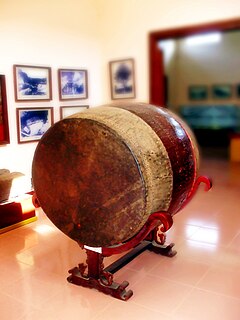
The trống cái or trống đại "great drum" is a traditional Vietnamese bass drum. It has a barrel-shaped wooden body, and gives a deep booming sound. The trong cai drums are typically hung on a stable frame, and in traditional drama the trống đại cổ is beaten to support the singers. It can also be carried and used at the head of a dragon dance procession.

The Esplanade of Sacrifice to the Heaven and Earth is an imperial altar situated south of the city of Huế, central Vietnam. It also known as the Nam Giao altar. It is dedicated to the heaven and earth. The complex was visited by the monarchs of the Nguyen dynasty for annual ceremonies of prayer to Heaven.
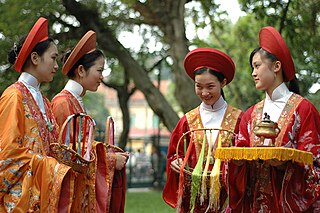
Khăn vấn, khăn đóng or khăn xếp, is a kind of turban worn by Vietnamese people which had been popular since ancient times. The word vấn means coil around. The word khăn means cloth, towel or scarf.

The seals of the Nguyễn dynasty can refer to a collection of seals specifically made for the emperors of the Nguyễn dynasty, who reigned over Vietnam between the years 1802 and 1945, or to seals produced during this period in Vietnamese history in general.
